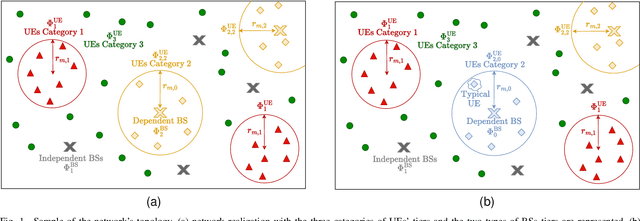Cellular Load Dependent Sleep Control for Energy Efficient HetNets with Non-Uniform User Distributions
Paper and Code
Feb 22, 2024



This study proposes a novel stochastic geometry framework analyzing power control strategies in spatially correlated network topologies. Heterogeneous networks are studied, with users modeled via the superposition of homogeneous and Poisson cluster processes. First, a new expression approaching the distribution of the number of users per base station is provided. This distribution defines the load associated with each Vorono\"i cell, capturing non-uniformities in user locations and correlation to BSs positions. The power allocation is adjusted based on this load, allowing BSs to enter sleep mode when their activity falls below a defined threshold. Furthermore, the propagation model features millimeter wave transmission characteristics and directional beamforming. Considering these aspects, revisited definitions of coverage probability, spectral efficiency, and energy efficiency are proposed. Tractable expressions for these metrics are derived and validated using Monte-Carlo simulations. Asymptotic expressions are also proposed, providing further understanding on the influence of the system parameters. Our numerical results finally analyze the impact of the sleep control on the performance and display the optimal strategies in terms of energy efficiency.
 Add to Chrome
Add to Chrome Add to Firefox
Add to Firefox Add to Edge
Add to Edge